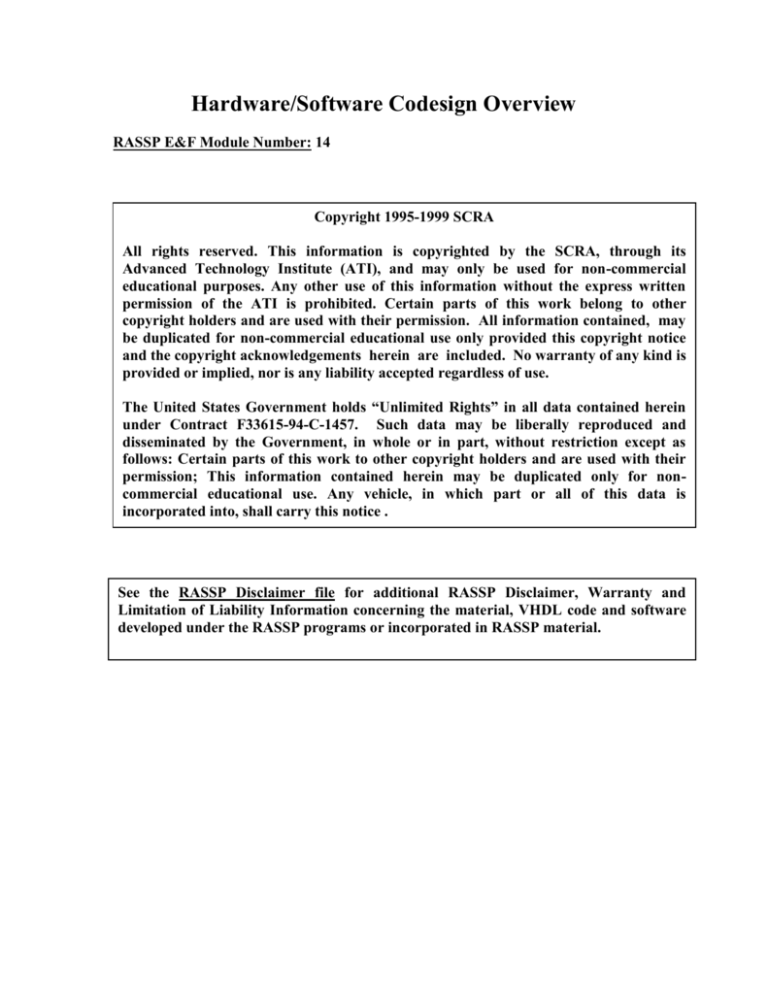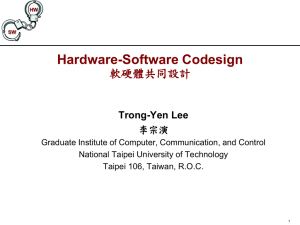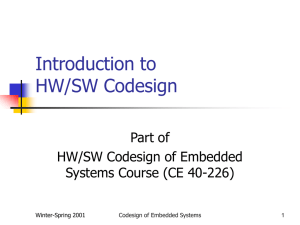
Hardware/Software Codesign Overview
RASSP E&F Module Number: 14
Copyright 1995-1999 SCRA
All rights reserved. This information is copyrighted by the SCRA, through its
Advanced Technology Institute (ATI), and may only be used for non-commercial
educational purposes. Any other use of this information without the express written
permission of the ATI is prohibited. Certain parts of this work belong to other
copyright holders and are used with their permission. All information contained, may
be duplicated for non-commercial educational use only provided this copyright notice
and the copyright acknowledgements herein are included. No warranty of any kind is
provided or implied, nor is any liability accepted regardless of use.
The United States Government holds “Unlimited Rights” in all data contained herein
under Contract F33615-94-C-1457. Such data may be liberally reproduced and
disseminated by the Government, in whole or in part, without restriction except as
follows: Certain parts of this work to other copyright holders and are used with their
permission; This information contained herein may be duplicated only for noncommercial educational use. Any vehicle, in which part or all of this data is
incorporated into, shall carry this notice .
See the RASSP Disclaimer file for additional RASSP Disclaimer, Warranty and
Limitation of Liability Information concerning the material, VHDL code and software
developed under the RASSP programs or incorporated in RASSP material.
Abstract: The Hardware/Software Codesign Overview module is intended to introduce
the hardware/software codesign to the practicing design, software, and systems
engineers, and to the senior undergraduate or first year graduate student. The
module provides key codesign concepts and attempts to show the benefits of the
codesign approach over the current design process.
The module consists of eight sections. The topic is introduced by defining
codesign, illustrating its usefulness, and introducing example systems that require
this new methodology. Also included is a discussion about the components that
make up an ideal codesign environment. The following sections are then
dedicated to discussing some of these components in more detail.
The second describes the unified representation for hardware and software that is
one of the components for an ideal codesign environment. Several candidate
description methods are discussed in some detail. The third section describes
techniques used to partition a system into hardware and software components. An
automated partitioning algorithm is the ideal way to go, but this is a difficult
enough problem that many codesign environments still leave this problem up to
the expertise of the user. The fourth section describes the integrated modeling
substrate that forms a component of an ideal codesign environment. This
modeling substrate allows the complete hardware/software system model to be
simulated at any point in the design process, which allows some degree of
validation to be performed. The fifth section briefly covers methodologies for
hardware and software synthesis from abstract system descriptions.
Finally, sixth section covers industrial approaches to hardware/software codesign,
specifically covering the Lockheed Saunders and Lockheed Martin ATL
approaches, and the seventh section gives a brief introduction into several
codesign systems being developed by universities. Example systems included are
Chinook, COSYMA, Ptolemy and POLIS.
Module Objectives:
To educate the hardware, software, and system designer on the fundamentals of
hardware/software codesign in a manner that will assist him/her in understanding
and employing cooperative hardware/software design techniques for the
construction of complex systems, particularly embedded systems.
Specific Objectives:
Provide information on:
1) Introduction of Hardware/Software Codesign
2) Design Issues, Trends, and Considerations
3) Current Hardware/Software Design Process
4) Issues and Directions in Hardware/Software Codesign
5) Hardware/Software Modeling Concepts
6) Hardware/Software Partitioning
7) Hardware/Software Synthesis
8) Hardware/Software Codesign Systems
Prerequisites:
Prerequisite Modules: None
Prerequisite Knowledge:
Fundamentals digital logic design, both combinational and sequential
Software engineering fundamentals
Syllabus:
1) Introduction
a) Codesign Definition
b) Motivation for Codesign
c) Categories of Systems and the Codesign Problem
d) Embedded Systems
e) Components of the Current Codesign Process
f) Components of the Ideal Codesign Process
(25 Slides)
2) Unified Hardware/Software Representations
(12 Slides)
3) HW/SW Partitioning Techniques
a) Partitioning Algorithms
b) Cost Metrics
c) Issues in Partitioning
(26 Slides)
4) Integrated HW/SW Modeling Methodologies
(7 Slides)
5) HW/SW Synthesis Methodologies
a) Hardware Synthesis
b) Software Synthesis
c) Interface Synthesis
d) Cosynthesis
(16 Slides)
6) Industry Approaches to HW/SW Codesign
(4 Slides)
7) Hardware/Software Codesign Research
a) Major Codesign Research Efforts
b) Chinook
c) COSYMA
d) Ptolemy
(30 Slides)
e) POLIS
9) Module Summary
(1 Slide)









